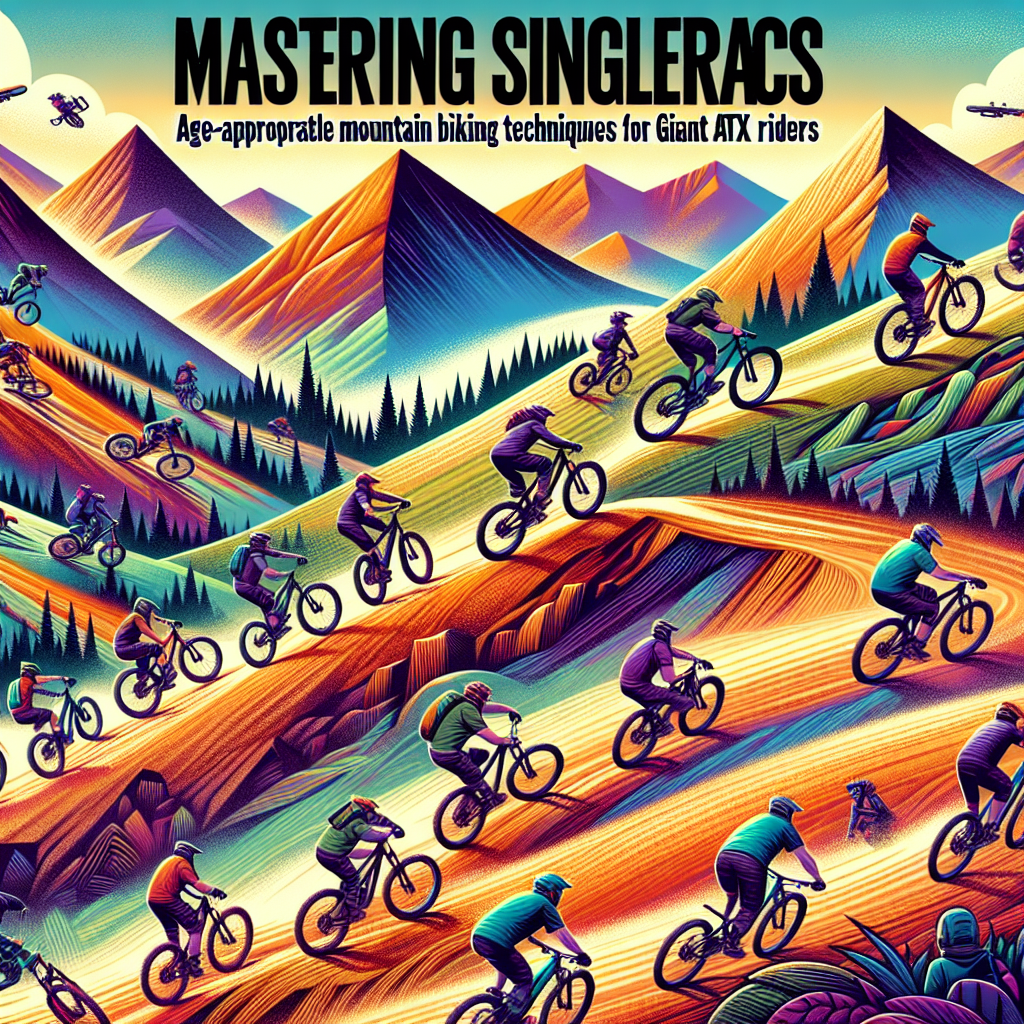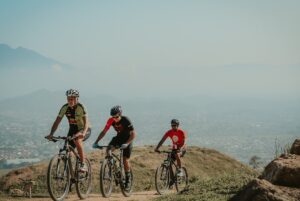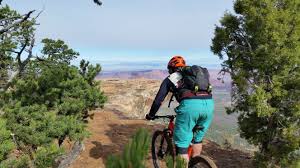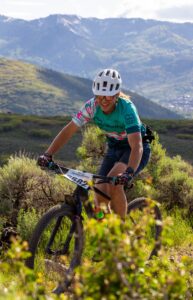
Key Takeaways: Article-at-a-Glance
- Learn the best mountain biking techniques tailored for all ages.
- Discover how to fine-tune your Giant ATX for peak performance.
- Follow a step-by-step guide to skillfully master singletrack trails.
- Understand the essentials of trail safety for a worry-free ride.
- Embark on your mountain biking journey with confidence and fun.
Top Techniques for Every Age on Singletracks
Whether you’re a sprightly youngster or a seasoned adult, singletracks call for a set of skills that match your age and ability. For the young guns, it’s about building a foundation of balance and control, while adults might focus on refining their technique to tackle more challenging terrain. Remember, mountain biking is a journey, not a race. Let’s explore how you can ride smarter, not harder, and enjoy every twist and turn the trail throws at you.
Optimizing Your Giant ATX for Mountain Biking
Your Giant ATX is more than just a bike; it’s your trusty steed for the rugged paths ahead. To get the most out of it, you’ll want to make sure it’s dialed in just right. This means checking the tire pressure, adjusting the suspension to suit your weight, and making sure the gears shift smoothly. A well-tuned bike not only rides better but also reduces the risk of mechanical issues that can cut your adventure short.
Step-by-Step Skill Development
Mastering the art of mountain biking doesn’t happen overnight. It’s about taking it one step at a time. Start with the basics like riding position and braking before moving on to more advanced skills like navigating tight corners and managing steep descents. Each ride is an opportunity to learn and grow, so be patient with yourself and celebrate the small victories along the way.

Ensuring Safety and Enjoyment on the Trails
Safety is paramount when you’re out on the trails. It’s what keeps the fun going and prevents a great day from turning into a not-so-great one. Always wear a helmet, check your equipment before you ride, and know your limits. Riding within your ability ensures you can come back and ride another day. And remember, the trail is there to be enjoyed, so soak in the sights, sounds, and smells of nature as you ride.
Hitting the Trails: Start Your Mountain Biking Adventure
There’s nothing quite like the feeling of hitting the trails on your Giant ATX. The wind in your face, the ground beneath your wheels, and the sense of freedom are exhilarating. Whether you’re new to the sport or looking to level up, the right techniques and a little bit of know-how will have you riding with confidence in no time.
Choosing the Right Giant ATX Model
Not all Giant ATX bikes are created equal. Depending on your age, height, and the type of riding you plan to do, there’s a model that’s just right for you. For the younger crowd, a smaller frame with lower standover height will make maneuvering easier. For taller riders, a larger frame will offer more stability and comfort. Let’s match you up with the perfect ATX so you can hit the trails with confidence.
Adjusting Your Bike to Fit Your Needs
Once you’ve picked out your Giant ATX, it’s time to make it truly yours. Adjusting the seat height for proper leg extension, setting the handlebar height for comfortable reach, and tweaking the suspension for your riding style can make a world of difference. A bike that fits well not only rides better but also helps prevent fatigue and injury. Let’s get you set up for success on the singletracks.
Understanding Balance and Bike Handling
Balance is the cornerstone of all biking skills, especially on the variable terrain of a mountain trail. Your Giant ATX is designed to support you, but it’s your job to distribute your weight effectively. Keep your body relaxed, your center of gravity low, and your eyes up, scanning the trail ahead. Bike handling is about making your ATX an extension of your body, reacting smoothly to the trail’s surprises. Practice on different surfaces and inclines; it’s the best way to become one with your bike.
Mastering the Art of Braking and Shifting Gears
Knowing when and how to brake and shift gears can make or break your ride. Smooth, controlled braking keeps you safe and maintains traction, while timely gear shifting allows you to keep your momentum. On your Giant ATX, practice feathering the brakes lightly instead of clamping down hard. As for gears, shift early to avoid the dreaded chain crunch. It’s all about anticipation and feeling the rhythm of the trail.
Intermediate Skills: Elevate Your Riding Technique
Once you’ve got the basics down, it’s time to step up your game. Intermediate skills are about refining what you know and adding a few tricks to your repertoire. This is where you start to feel like the trail is a dance and your Giant ATX is your partner. You’ll learn to pump the terrain for speed, use obstacles to your advantage, and ride with greater efficiency. Each new skill is a tool in your toolbox, ready to be used when the trail calls for it.

Conquering Climbs with Control and Power
Climbing is as much a mental game as it is physical. On your Giant ATX, approach climbs with a positive attitude and steady cadence. Keep your weight distributed so the front wheel stays grounded without losing traction at the back. Breathe deeply, and use your gears wisely to maintain a consistent effort. Conquering climbs is about endurance and smart energy use. With practice, you’ll start to seek out hills just for the thrill of the ascent.
Perfecting Your Cornering to Ride Smoother
Cornering is where many riders lose speed or, worse, crash. To corner like a pro on your Giant ATX, approach with your outside foot down and weight on that pedal. Lean the bike, not your body, into the turn, and look where you want to go, not at the obstacles you’re trying to avoid. Smooth cornering is about trust in your bike’s grip and your own ability to read the trail. Practice makes perfect, so find some turns and get to it!
Advanced Techniques for Skillful Riders
Ready to really push the envelope? Advanced techniques are about finesse and precision. This is where you’ll learn to ride sections of trail that once seemed impossible. Your Giant ATX is capable, but are you? It’s time to find out. Let’s get into the nitty-gritty of what it takes to join the ranks of the mountain biking elite.
Navigating Steep Descents with Confidence
Steep descents can be intimidating, but your Giant ATX is built to handle them. The key is to stay loose, keep your weight back, and let the bike move beneath you. Use your brakes wisely to control speed, but don’t lock them up. Trust in your tires and suspension to do their job. With each descent, your confidence will grow, and what once seemed steep will become just another fun challenge.
Executing Drops and Jumps Like a Pro
Drops and jumps are the showstoppers of mountain biking. Start small and work your way up. On a drop, the goal is to keep your bike level in the air. Compress into the bike as you approach the edge and push the handlebars forward as you take off. For jumps, it’s all about timing the compression and release. Practice these techniques in a controlled environment before taking them to the trail. When you nail that first drop or jump, the feeling is unbeatable.
Riding with Precision: Technical Skills for Challenging Trails
When the trail gets tough, the tough get going. Technical trails demand a higher level of skill and focus. It’s about making the right move at the right time. Your Giant ATX is up to the task, with its agile frame and responsive handling. But it’s you who must pilot it through the rock gardens and root labyrinths. Precision riding is about knowing your bike, understanding the trail, and making quick, informed decisions.
Tackling Obstacles: Logs, Rocks, and Roots
Obstacles are what make mountain biking an adventure. They’re the moments that get your heart racing and test your skills. When faced with a log, approach with momentum and lift the front wheel just enough to clear it, then allow the rear to follow. For rocks and roots, it’s about choosing the smoothest line and using your body to absorb the bumps. Keep your eyes ahead, plan your moves early, and always be ready to adjust. It’s like a dance, and your Giant ATX is your partner.

Maintaining Momentum through Technical Terrain
Momentum is your friend on the trail. It helps you glide over obstacles and maintain control. The key is to keep pedaling, even when it gets rough. Use your body to maneuver the bike, keeping it light over obstacles while your legs keep the power on. It’s a delicate balance between force and finesse, but when you get it right, you’ll flow through technical terrain as if it were flat ground.
Race Against Time: Tips for Speed and Efficiency
Speed is exhilarating. It’s the rush of the wind, the blur of the scenery, and the quickening of your pulse. But speed without efficiency is like running through a storm with a parachute. It’s about being smart with your energy, knowing when to push and when to conserve. On your Giant ATX, every pedal stroke counts, every gear shift matters, and the line you choose can save seconds, or more importantly, save your energy.
Finding Your Rhythm: The Importance of Cadence
Cadence is the beat of your mountain biking drum. It’s the steady rhythm of your pedals that propels you forward. A consistent cadence keeps your energy levels balanced and your muscles fresh. On climbs, find a gear that allows you to maintain a steady pace without burning out. On flats, it’s about finding that sweet spot where speed and effort meet. Listen to the rhythm of your ride and let it guide you.
Strategies for Faster Climbs and Descents
Speed on climbs is about conserving energy and using your power wisely. Stand up on the pedals when you need leverage, sit down to engage more muscle groups, and always keep a steady rhythm. Descents are where you can make up time, but control is key. Lower your center of gravity, brake before the turns, and let your bike do the work. Fast is fun, but fast and in control is even better.
Practice Makes Perfect: Drills and Exercises to Improve
They say practice makes perfect, and they’re not wrong. The more you ride, the better you get. But it’s not just about riding; it’s about practicing with purpose. Drills and exercises can target specific skills, build muscle memory, and turn your weaknesses into strengths. On your Giant ATX, every ride is an opportunity to improve. Let’s dive into some drills and exercises that will take your riding to the next level.
Exercises to Enhance Your Balance and Agility
Balance and agility are the foundation of all mountain biking skills. They keep you upright on the bike and responsive to the trail. Try exercises like slow-speed riding to hone your balance, and slalom drills to improve your agility. Use cones, or natural markers on the trail, to weave in and out, challenging your ability to make quick turns. The more you practice, the more your bike will feel like an extension of yourself.
Trail Practice: Applying Skills in Real Scenarios
Now that you’ve got a handle on the basics, it’s time to take those skills to the trails. Real-world practice is where it all comes together. Start with easier, well-maintained trails and gradually work your way up to more challenging terrain. Pay attention to how different surfaces affect your ride. Gravel, mud, and loose dirt all require slight adjustments in handling. Remember, it’s about progress, not perfection. Each ride is a chance to learn and improve.

“Mountain bikers heading up Mustard Hill …” from www.geograph.org.uk and used with no modifications.
Strategies from Top Riders on Singletracks
Ever wonder how the pros make it look so easy? It’s all about strategy. Top riders know the trail like the back of their hand. They plan their moves in advance, stay relaxed, and conserve energy for when they need it most. They also know the importance of recovery and nutrition. So, take a leaf out of their book: study the trail, pace yourself, eat well, and rest properly. With the right strategy, you’ll be riding like a pro in no time.
Custom Drills for Age-Specific Development
Mountain biking skills can and should be tailored to the rider’s age. For the younger crowd, focus on fun drills that build confidence and control, like obstacle courses or balance games. For teens and adults, drills can be more about endurance and technical skills, like timed hill climbs or navigating narrow singletracks. The key is to challenge yourself, but also to ensure the drills are appropriate for your age and skill level.
Staying Safe and Prepped: Mountain Biking Etiquette and Maintenance
Mountain biking is not just about the ride; it’s also about respecting the trails and your fellow riders. Good etiquette ensures everyone has a great time and the trails stay in good shape for future rides. And when it comes to your bike, regular maintenance is crucial. A well-maintained bike is a safer, more reliable ride. Let’s dive into the essentials of trail etiquette and bike maintenance.
Trail Safety Tips for Solo and Group Rides
Whether you’re riding solo or with friends, safety always comes first. If you’re on your own, let someone know where you’re going and when you expect to be back. Always carry a map, water, and a basic repair kit. In a group, ride within the abilities of the least experienced rider, and communicate clearly about obstacles and turns. No matter how you ride, be aware of your surroundings and ride responsibly.
Keeping Your Giant ATX in Top Condition
Your Giant ATX is a trusty companion on the trails, but it needs regular TLC to perform its best. Keep it clean, especially after muddy rides. Check the tire pressure, brakes, and gears before every ride, and don’t forget to lubricate the chain regularly. If you hear any strange noises or notice anything off with the handling, get it checked out. A well-cared-for bike means a smoother, safer ride.
Ready for the Next Step: Upgrading and Customizing Your Ride
As you grow as a rider, you might start to feel like your bike needs to grow with you. Upgrading components can improve performance, comfort, and even the look of your bike. But it’s not just about throwing on the latest and greatest parts; it’s about making thoughtful upgrades that match your riding style and goals. Let’s talk about when and how to upgrade your Giant ATX.
When to Upgrade Your Giant ATX Components
So, when is it time to upgrade? Start with the parts that will make the most difference to your ride. If you’re looking for more comfort, consider a better saddle or grips. For improved performance, look at the wheels and tires, which can reduce weight and increase traction. And if you’re after better handling, upgrading the suspension can make a big impact. Think about what you want to achieve with your ride, and plan your upgrades accordingly.
Personalizing Your Bike for Maximum Performance
Your Giant ATX isn’t just any bike—it’s your bike. And making it uniquely yours is part of the mountain biking experience. Personalization goes beyond aesthetics; it’s about tweaking your ride to fit your style and needs. Swap out the handlebars for a different width or rise to change your control dynamics. Choose pedals that match your shoes for better grip. Even changing the saddle can lead to a more comfortable ride. Each change should enhance your connection with your bike and make every ride better than the last.
![]()
“Close up of a bike | Free Photo – rawpixel” from www.rawpixel.com and used with no modifications.
Frequently Asked Questions
How do I choose the right size Giant ATX bike for my child?
Choosing the right bike size is crucial for your child’s comfort and safety. Start by measuring their height and inseam length. Giant ATX bikes come in various sizes, so refer to the size chart specific to the model you’re considering. The right size bike will allow your child to comfortably reach the ground with their feet when seated and have a slight bend in the knee when the pedal is at its lowest point. If in doubt, consult with a local bike shop for expert advice.
What are the essential safety gears for mountain biking at different ages?
Safety gear is non-negotiable, no matter your age. Here’s a quick rundown:
- Helmet: A properly fitted helmet is essential for riders of all ages.
- Gloves: They provide better grip and protect your hands in a fall.
- Elbow and knee pads: Especially important for kids and beginners.
- Eye protection: Goggles or glasses to keep the dirt and bugs out.
- Proper shoes: Footwear should be sturdy with good grip.
- Hydration pack: For all riders to stay hydrated on the trails.
Remember, the right gear can make a big difference in both safety and enjoyment.
Can the same mountain biking skills be applied to all trail types?
While core mountain biking skills like balance, braking, and shifting are universal, different trails require different approaches. For example, sandy trails demand a looser grip and lower tire pressure for better traction, while rocky trails require precise line choice and body positioning. The key is to adapt your fundamental skills to the terrain you’re riding. Practice on various types of trails to become a versatile rider.
How often should I service my Giant ATX for optimal performance?
Regular maintenance is the secret to keeping your Giant ATX running smoothly. Here’s a simple timeline:
- After every ride: Clean your bike and check for any damage.
- Every few rides: Lubricate the chain and check tire pressure.
- Every few months: Check brake pads, cables, and bearings for wear.
- Annually: Get a professional tune-up to ensure everything is in top shape.
Sticking to this schedule will help prevent breakdowns and costly repairs.

As you embark on your mountain biking journey, remember that your Giant ATX is more than just a vehicle for the trails—it’s a passport to adventure, a tool for fitness, and a means to connect with nature. Whether you’re a young rider just starting out or an adult honing your skills, the right techniques, a well-maintained bike, and a personalized setup will enhance your experience. Stay curious, keep learning, and above all, enjoy the ride. Happy trails!


